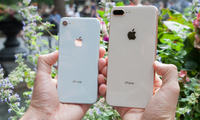iPhone 8 vs. Galaxy S8: Samsung Wins Flagship Phone Battle
Samsung’s Galaxy S8 blows away the iPhone 8, but it’s a lot closer between the iPhone 8 Plus and the Galaxy S8+.
The Galaxy S8 and iPhone 8 come from different worlds. And I’m not just talking about their operating systems. The Android-powered Galaxy S8 and Galaxy S8+ are all about looking sleek with their edge-to-edge Infinity Displays, and Samsung backs up its head-turning designs with a new Bixby assistant, and fast and very capable cameras.
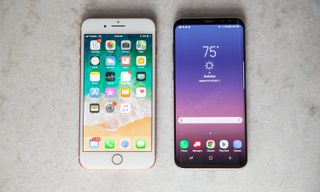
With the iPhone 8 and iPhone 8 Plus, it’s all about what’s on the inside, including the phones’ blazing A11 Bionic chip, bigger and faster camera sensors, and the overdue addition of wireless charging. iOS 11 offers plenty of handy new features, too. So what should you buy? I put these flagships through seven rounds of competition to declare a winner, and it’s Samsung by a nose.
Update Dec. 7: If you're looking to save money on these premium flagships, we have you covered for holiday deals on the Galaxy S8 and iPhone 8.We've also added information on quick charging results.
iPhone 8 vs. Galaxy S8: Specs Compared
| Row 0 - Cell 0 | iPhone 8 | Galaxy S8 | iPhone 8 Plus | Galaxy S8+ |
| Price | $700, $850 | $725 to $750 | $800, $950 | $825 to $850 |
| Display | 4.7 inches (1334 x 750 LCD) | 5.8 inches (2960 x 1440) Super AMOLED | 5.5 inches (1920 x 1080 LCD) | 6.2 inches (2960 x 1440) Super AMOLED |
| CPU | A11 Bionic | Snapdragon 835 | A11 Bionic | Snapdragon 835 |
| Storage | 64GB, 256GB | 64GB | 64GB, 256GB | 64GB |
| microSD | No | Up to 256GB | No | Up to 256GB |
| Rear Camera | 12 MP (f/1.8) | 12 MP (f/1.7) | Dual 12 MP (f/1.8, f/12.8) | 12 MP (f/1.7) |
| Front Camera | 7 MP (f/2.2) | 8 MP (f/1.7) | 7 MP (f/2.2) | 8 MP (f/1.7) |
| Battery Life | 9:54 | 10:39 | 11:16 | 11:04 |
| Colors | Gold, Silver, Space Gray | Midnight Black, Orchid Gray, Arctic Silver | Gold, Silver, Space Gray | Midnight Black, Orchid Gray, Arctic Silver |
| Dimensions | 5.5 x 2.7 x 0.29 inches | 5.9 x 2.7 x 0.3 inches | 6.2 x 3.1 x 0.3 inches | 6.3 x 2.9 x 0.3 inches |
| Weight | 5.22 ounces | 5.5 ounces | 7.13 ounces | 6.1 ounces |
Design
Sure, with their glass backs, the new iPhone 8 and 8 Plus look a bit different from their predecessors, but they’re identical to the iPhone 7 and iPhone 7 Plus from the front. And that’s not a good thing, because those thick bezels look downright old-fashioned next to Samsung’s flashier phones.
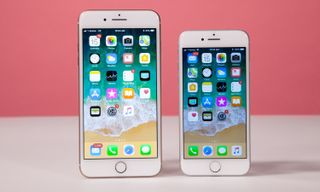
The Galaxy S8 and S8+ boast gorgeous Infinity Displays that stretch from edge to edge up front, complete with a sexy curve. And because these screens have a narrow 18.5:9 aspect ratio, it’s easy to use even the big-screen, 6.2-inch S8+ with one hand. It’s a real stretch to do so with the iPhone 8 Plus, even though it has a smaller, 5.5-inch display.
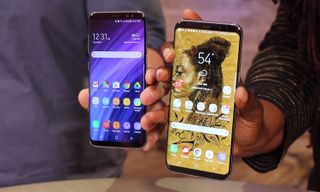
The Galaxy S8 weighs nearly the same as the iPhone 8, even though Apple’s regular iPhone 8 has a screen that’s an inch smaller. The Galaxy S8+ weighs a full ounce lighter than the iPhone 8 Plus.
All four of these phones offer water resistance, but the Galaxy S8 and S8+ don’t sacrifice a headphone jack for a sealed design.
Winner: Galaxy S8 and S8+
Display
Everything looks better with an OLED screen, from the perfect black levels and more saturated colors to the wider viewing angles. And both the 5.8-inch Galaxy S8 and the 6.3-inch S8+ demonstrate those advantages over the iPhone 8 and 8 Plus’ 4.7-inch and 5.5-inch LCDs beautifully.
While the iPhone 8 and iPhone 8 deliver anywhere from 119 to 125 percent of the color gamut, the Galaxy S8 and S8+ exceed 180 percent. However, both Apple phones were neck and neck with Samsung’s devices in terms of color accuracy, as all of the handsets registered Delta-E scores below 1 (0 is perfect).
In addition, the S8 and S8+ produce sharper images than the latest iPhones, thanks to their higher resolution of 2960 x 1440 pixels. The iPhone 7 is way behind in both size and resolution, at 4.7 inches and 1334 x 750 pixels. At least the iPhone 7 Plus’ 5.5-inch panel is full HD at 1920 x 1080.
Winner: Galaxy S8 and S8+
Performance
Powered by Qualcomm’s Snapdragon 835 processor, the Galaxy S8 and S8+ are among the fastest Android phones available. But the A11 Bionic chip in the iPhone 8 and 8 Plus is in another league, as we discovered during our in-depth speed tests.

On Geekbench 4, which measures overall performance, the latest iPhones scored over 10,000, while the Galaxy S8 and S8 Plus didn’t crack 6,300. The results were similar on 3DMark Ice Storm Unlimited, which measures graphics performance: Both the iPhone 8 and 8 Plus surpassed 62,000, while the S8 and S8+ were in the 36,000 range.
In a real-world video-editing test, in which our lab rendered a 2-minute 4K video using the Adobe Clip app, the iPhone 8 took only 42 seconds, compared with more than 4 minutes for the Galaxy S8.
Winner: iPhone 8 and 8 Plus
Cameras
This is a close call, as the cameras on the iPhone 8 and 8 Plus and Galaxy S8 and S8+ excel in different types of conditions, but the iPhone 8 Plus is a bit better.
MORE: 30 Great Photos Taken With the iPhone 8
Both the iPhone 8 and 8 Plus benefit from a faster and larger sensor than the iPhone 7 and 7 Plus, but only the Plus model has dual cameras, which enables a 2x optical zoom and a nifty Portrait Mode that blurs out the background. If you want dual cameras from Samsung, you’ll have to step up to the more expensive Galaxy Note 8.
When I compared shots taken by the iPhone 8 and Galaxy S8 side by side, Apple’s phone had the edge in brighter lighting.
Take the photos of this lantana flower. The Galaxy S8 image looks blown out and less detailed; the shot from the iPhone allows you to make out more of the petals and delivers more vibrant yellow, pink and coral.
Apple’s and Samsung’s phones were more evenly matched when I snapped a photo of the Empire State Building behind a fountain and trees. While both the iPhone 8 and Galaxy S8 faithfully captured the scene, the blue in the sky and green in the potted plant next to the fountain look richer in the iPhone’s shot.
In low light, the Galaxy S8 evens the score, letting in more light with its f/1.7 lens, compared with f/1.8 for the iPhone 8.
Our racoon friend here and the surrounding table look brighter in Samsung’s photo.
When I turned on the flash, though, for both phones, the raccoon looked more white-washed in the S8 image.
Winner: iPhone 8 and 8 Plus
Special Features
Apple has finally added wireless charging to the iPhone; both handsets work with charging pads that support the Qi standard. Samsung has offered this feature for years, though. Even better, you get fast wired charging out of the box via USB-C with the Galaxy S8 and S8+. With the iPhone 8 and 8 Plus, you have to pay extra for a beefier power brick and a USB-C-to-Lightning cable.
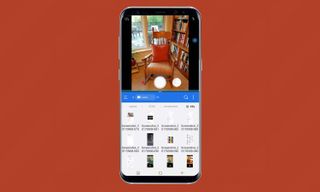
The Galaxy S8 and S8+ also let you run two applications side by side, thanks to their Multiwindow feature. Other special Samsung features include the Bixby personal assistant, which lets you accomplish all sorts of multistep tasks using your voice; an optional DeX dock, which turns this phone into a mini PC; and the Gear VR accessory, which lets you experience VR apps, movies and games.
The iPhone 8 and 8 Plus don’t offer many special features, but there are several welcome additions in the latest iOS 11 software. For instance, you can edit Live Photos, enjoy a new breed of immersive augmented-reality apps, and (soon) send money to friends in the Messenger app. Like the S8, the iPhone 8 has its own personal assistant, and Siri is a little more polished.
Winner: Galaxy S8 and S8+
Battery Life
The good news is that none of these phones will let you down on the endurance front.

On the Tom’s Guide Battery Test, which involves continuous web surfing over 4G LTE on 150 nits of screen brightness, the iPhone 8 and iPhone 8 Plus lasted 9 hours and 54 minutes and 11 hours and 16 minutes, respectively.
MORE: Smartphones with the Longest Battery Life
The Galaxy S8 and S8+ lasted for 10:39 and 11:04, respectively. So the smaller Galaxy S8 lasted a good deal longer than the iPhone 8, but Apple had a slight edge when the two plus-size handsets were compared.
The iPhone 8 and iPhone 8 Plus can charge faster than the Galaxy S8 and S8+ based on our tests. Provided you're willing to spring for a 29-watt charger and a USB-C to Lightning cable, the iPhone 8 can reach 49 percent charge in just 30 minutes. The iPhone 8 hit 47 percent in the same time.
The Galaxy S8 and Galaxy S8+ reached 37 and 38 percent, respectively, in the same amount of time.
Winner: Draw
Value
All four of these devices command a premium, but Apple’s phones have slightly lower starting prices, of $699 and $799. Samsung’s handsets cost $25 to $50 more to start.
Apple also offers you the option of quadrupling your storage to 256GB for $150 more, which will give you plenty of room for games and 4K video. However, Samsung’s phones have microSD card slots that can accommodate 256GB microSD cards, which run $130 to $145.
Winner: iPhone 8 and 8 Plus
Overall Winner
Based on our scorecard, the iPhone 8/8 Plus and Galaxy S8/S8+ are tied at 4 points apiece. But we give the Galaxy S8 the win over the iPhone 8. The verdict between the iPhone 8 Plus and Galaxy S8+, however, is more of a toss-up.
| Row 0 - Cell 0 | iPhone 8/8 Plus | Galaxy S8/S8+ |
| Design | Row 1 - Cell 1 | ✓ |
| Display | Row 2 - Cell 1 | ✓ |
| Performance | ✓ | Row 3 - Cell 2 |
| Cameras | ✓ | Row 4 - Cell 2 |
| Special Features | Row 5 - Cell 1 | ✓ |
| Battery Life | ✓ | ✓ |
| Value | ✓ | Row 7 - Cell 2 |
| Overall | 4 | 4 |
The main reason the regular S8 wins over the iPhone 8 is you get a bigger and better 5.8-inch display in a sexier design. The puny 4.7-inch panel on the iPhone now seems antiquated.
The iPhone 8 Plus makes up for its chunky bezels with its better dual cameras and faster performance than those of the S8+ at a lower starting price. But the S8+ is still great, because it gives you a larger, 6.2-inch display in a more attractive and one-hand-friendly device while lasting almost as long on a charge.
Want a Galaxy S8-like design running iOS? You’re better splurging for the iPhone X — if you can afford a $999 phone. You can check out our iPhone X vs Galaxy S8 face-off here.
Credit: Tom's Guide
Sign up to get the BEST of Tom’s Guide direct to your inbox.
Upgrade your life with a daily dose of the biggest tech news, lifestyle hacks and our curated analysis. Be the first to know about cutting-edge gadgets and the hottest deals.
Mark Spoonauer is the global editor in chief of Tom's Guide and has covered technology for over 20 years. In addition to overseeing the direction of Tom's Guide, Mark specializes in covering all things mobile, having reviewed dozens of smartphones and other gadgets. He has spoken at key industry events and appears regularly on TV to discuss the latest trends, including Cheddar, Fox Business and other outlets. Mark was previously editor in chief of Laptop Mag, and his work has appeared in Wired, Popular Science and Inc. Follow him on Twitter at @mspoonauer.
